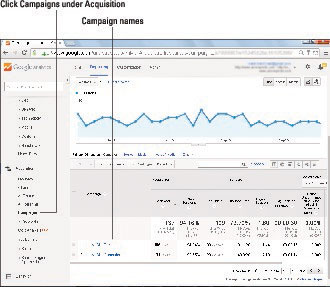Tagging links offers one other advantage: the ability to track the impact of dark social media traffic. Dark traffic arrives at your site via an intermediate stop on some site other than the social media page on which you posted your original link. (For instance, someone shares the link you placed on Facebook with one of their friends via email or text message.) Unless you tag your links, Google can’t identify traffic from these sources, so it gets reported as direct traffic.
An unidentified referrer is usually displayed on a row with only a / (slash) in its name. This unspecified / category includes people who type your URL on the address bar of their browsers because they remembered it, were told about it, or have bookmarked your site.Tagging links manually
If you have only a few such unspecified sources, simply tag the inbound link with additional, identifying information. Add ?src= and the landing page URL. Follow that, in any order, with the source (where the link appeared, such as MerchantCircle), the medium (pay-per-click, banner, email, and so forth), and campaign name (date, slogan, promo code, product name, and so on). Separate each variable with an ampersand (&). The tagged link will look something likewww.yoursite.com/landingpage?src=yahoo&banner&july14.
Google AdWords does this tracking for you automatically. Be sure that you have linked your Analytics and AdWords accounts together and enable auto-tagging. You can still use either the manual method described in this section or the Google tag builder described in the following section for all non–AdWords campaigns.
Using Google’s URL builder to tag links
Google’s automated tool for creating tagged links can be used for any advertising campaign or medium, not just Google AdWords. Follow these steps:- Go to https://support.google.com/analytics/answer/1033867.
- Enter your website’s address in the Website URL text box.
- In the Campaign Source text box, enter the referrer, such as Facebook, newsletter, Google Ads, and so on.
- Enter the type of ad in the Campaign Medium text box. For example, the ad type may be promoted post, banner, retargeting, or print.
- (Optional) Enter keywords or target audience demographics in the Campaign Term text box.
- (Optional) Include text from the body or headline of each ad in the Campaign Content text box to differentiate ads. This step is often helpful for A/B testing when you’re trying to decide which headline or offer works better in an ad.
- In the Campaign Name text box, enter an easily identifiable product name, slogan, promo code, holiday, or theme.
- Click the Submit button. Your custom URL, which appears below the button, looks something like
<a href="http://www.watermelonweb.com/?utm_campaign=holidayparties2014&utm_medium=banner&utm_source=chambernewsletter">www.watermelonweb.com/?utm_campaign=holidayparties2014&utm_medium=banner&utm_source=chambernewsletter</a>.

You can easily track results for non-AdWords campaigns in Google Analytics.
You can use tagged links to identify traffic coming from offline sources. Create an obvious, easy-to-remember URL for print, radio, or TV ads that looks something like www.yoursite.com/tv. Then ask your programmer to create a redirect from the obvious URL to your tagged link. Because the tagged link will show up as the referrer in Google Analytics, you can determine how successfully your offline advertising drives traffic to your site. Redirects are a great way to distinguish how often your video ads are seen on YouTube versus television, for example.
The process of tagging links may be time consuming, but being able to monitor a particular campaign more accurately is worth your trouble.Generate a separate, unique, shortened link for tweets, LinkedIn updates, and mobile sites, if needed. Always test to ensure that the modified link works correctly.

